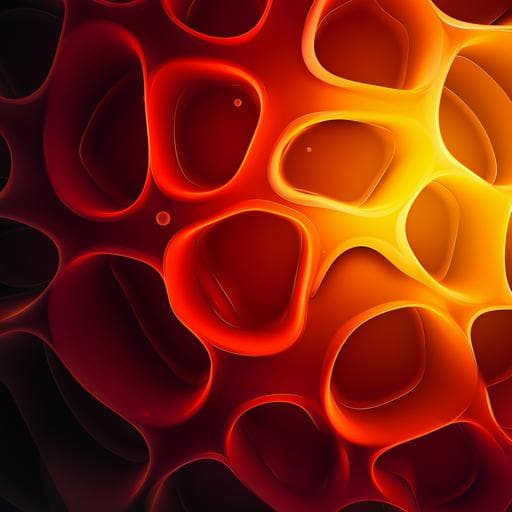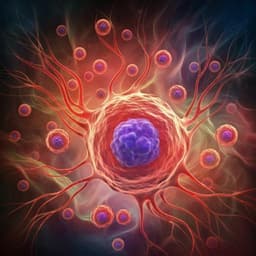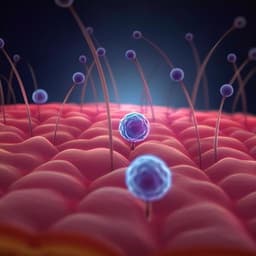
Medicine and Health
3D cell culture using a clinostat reproduces microgravity-induced skin changes
D. H. Choi, B. Jeon, et al.
Discover groundbreaking research on how microgravity influences skin health, revealing critical changes such as increased endothelial thickness and altered collagen expression. This study, conducted by Dong Hyun Choi, Byoungjun Jeon, Min Hyuk Lim, Dong Hun Lee, Sang-Kyu Ye, Seung-Yong Jeong, and Sungwan Kim, highlights the innovative use of a 3D clinostat to simulate microgravity's effects on skin physiology.
~3 min • Beginner • English
Introduction
Astronauts are exposed to microgravity during spaceflight, which alters multiple physiological systems including bone, muscle, brain, cardiovascular function, and fluid distribution. The skin is among the most affected organs, with frequent reports of rashes, hypersensitivity, irritation, dermatitis, peeling, infection, and post-flight thinning and elasticity loss. Mouse studies after long-duration exposure to microgravity reported decreased dermal thickness and altered collagen turnover. Endothelial cells, key to dermal vasculature, show microgravity-induced angiogenic responses and morphological changes, which are implicated in inflammatory skin disorders and irritation. Because spaceflight studies are costly and impractical, clinostats can simulate microgravity by constantly changing the gravity vector to create a time-averaged simulated microgravity (taSMG) environment. While many prior studies used 2D cultures, 3D culture systems (spheroids/organoids) better recapitulate in vivo cell behavior and extracellular matrix interactions. This study used a validated 3D clinostat to generate taSMG and tested whether skin-relevant physiological changes can be reproduced in a 3D in vitro model comprising keratinocyte–fibroblast co-cultured spheroids and endothelial cell arrangements.
Literature Review
Methodology
Clinostat setup: A previously developed and validated 3D clinostat generated time-averaged simulated microgravity (taSMG) < 10^-3 G. Two perpendicular frames rotated at low angular velocities (inner frame: 0.683 rpm; outer frame: 0.913 rpm) to avoid repetitive gravity vectors; Coriolis, radial, and frictional forces were considered negligible.
Cell lines and culture conditions: Human epidermal keratinocytes HaCaT and human skin fibroblasts Hs27 were cultured in high-glucose DMEM with 10% FBS and 1% penicillin/streptomycin. HUVECs were cultured in EGM-2 supplemented with growth factors and 20% FBS. Cells (passages 3–10) were maintained at 37 °C, 5% CO2.
Endothelial arrangement assay: Matrigel was polymerized in 96-well plates (1 h at 37 °C). HUVECs (150 µL at 2×10^5 cells/mL) were seeded and allowed to attach for 2 h. After adding 200 µL medium and sealing, groups were incubated for 18 h under 1G or taSMG. A 1G-to-taSMG group was incubated 9 h at 1G then 9 h at taSMG. Endothelial arrangements were imaged (Nikon Eclipse Ts2, 4×); thickness quantified (n=8–9) via ImageJ.
Spheroid cultures: 96-well ultra-low attachment plates were used. Mono-culture spheroids: 10,000 fibroblasts/well or 10,000 keratinocytes/well. Co-culture spheroids: 10,000 fibroblasts seeded first; after 24 h (fibroblast core formation), 10,000 keratinocytes added. Spheroids were sealed and cultured under 1G or taSMG for 3 days; formation imaged (4×).
Cell viability: PrestoBlue HS reagent (20 µL into 200 µL medium per well) was incubated 4 h at 37 °C; fluorescence measured at Ex 560 nm/Em 590 nm. Blanks were medium + reagent. Viability compared across mono- and co-cultures over 3 days.
Spheroid thickness and cell size: Fibroblasts labeled with CellTracker Red CMPTX; keratinocytes with CellTracker Green CMFDA prior to seeding. Confocal microscopy (Leica TCS SP8) captured images under 1G and taSMG. Thickness of keratinocyte outer layer, fibroblast core, and total spheroid diameter were measured using ImageJ 1.53c. Keratinocyte cell size in co-cultured spheroids was also quantified (CellTracker Red used for size measurement in specified assays). Replicates: typically n=8 per group.
Immunofluorescence staining: Spheroids were fixed (4% PFA, 30 min), cryoprotected (20% sucrose, overnight), embedded in OCT, cryosectioned at 10 µm. Sections were permeabilized (0.1% Triton X-100), blocked (5% BSA), and stained with rabbit anti-collagen I and mouse anti-cytokeratin 10 (K10), followed by appropriate Alexa Fluor 647 secondary antibodies; nuclei counterstained with DAPI; imaged by confocal microscopy.
Hydroxyproline assay: Co-cultured spheroids (grown with ascorbic acid) were hydrolyzed with 12 N HCl for 3 h, clarified with activated charcoal (10,000 × g, 3 min), and assayed colorimetrically at 560 nm per manufacturer’s protocol to quantify collagen content at days 3 and 7.
Quantitative real-time PCR: Total RNA isolated with TransZol Up; cDNA synthesized with oligo(dT)18. qRT-PCR (Bio-Rad CFX Connect) with SYBR Green master mix using primers for COL1A1, MMP1, P4HA1, CCN1, CCN2, and K10 (GAPDH reference). Cycling: 50 °C 2 min, 95 °C 3 min, then 45 cycles of 95 °C 15 s, 60 °C 30 s, 72 °C 1 min. Relative expression calculated by 2^-ΔΔCT. Typical n=4.
Statistics: Data presented as mean ± SEM. Analyses performed in SPSS 25; imaging analyses in ImageJ; plots in GraphPad Prism 5. Tests included Student’s t-test, Mann–Whitney U test, and ANOVA as appropriate. Two-sided p-values with significance thresholds *p < 0.05, **p < 0.01.
Key Findings
- Endothelial arrangement thickness (Matrigel tube assay): Compared to 1G, 1G-to-taSMG increased thickness by 12.92% (p=0.04) and taSMG by 59.75% (p=0.01); all groups differed significantly (p=0.03), indicating enhanced angiogenic structuring under taSMG.
- Spheroid morphology under taSMG: After 3 days, co-cultured spheroids showed reduced keratinocyte layer thickness by 5.11% (p=0.02) and fibroblast core thickness by 9.44% (p=0.05), yielding a 6.66% decrease in total diameter (p<0.01). Keratinocyte cell size in co-cultured spheroids was significantly reduced under taSMG (p<0.05).
- Viability: Under taSMG, viability increased for keratinocyte mono-culture and co-cultured spheroids, but decreased for fibroblast mono-culture spheroids (3D). In 2D culture, fibroblast viability increased under taSMG (Supplementary data).
- ECM-related gene expression (co-cultured spheroids): COL1A1 was significantly upregulated under taSMG; CCN2 (CTGF) was significantly downregulated. MMP1, P4HA1, and CCN1 showed no significant changes in 3D (contrasting with increased expression in 2D under taSMG in Supplementary data).
- Collagen content: Hydroxyproline assay showed no significant change at day 3, but a significant increase at day 7 under taSMG, consistent with COL1A1 upregulation.
- Epidermal differentiation marker: K10 expression increased significantly under taSMG in both 3D co-cultured spheroids (p=0.04) and 2D culture (Supplementary data).
- Overall, taSMG reproduced features consistent with microgravity-associated skin changes: enhanced endothelial structuring suggestive of vasodilation/irritation and reduced spheroid thickness indicative of skin thinning.
Discussion
The study demonstrates that time-averaged simulated microgravity generated by a 3D clinostat induces skin-relevant cellular and structural changes in vitro. Enhanced endothelial arrangement thickness under taSMG is consistent with increased angiogenesis and vascular dilation/permeability, offering a mechanistic basis for astronauts’ frequent skin irritation (erythema, edema). Such vascular changes may also contribute to reported facial fullness and headaches during space adaptation.
Co-cultured skin spheroids exhibited decreased thickness of both the keratinocyte layer and fibroblast core under taSMG, paralleling dermal thinning observed in astronauts and in mice after prolonged microgravity. Downregulation of CCN2 (CTGF), which supports fibronectin-mediated adhesion and matrix maintenance, may contribute to dermal matrix impairment and thinning, while COL1A1 upregulation and delayed increases in collagen content (day 7) suggest time-dependent ECM remodeling under taSMG. Differences between taSMG and real microgravity reported in prior studies (e.g., CCN1/CCN2 upregulation in some in vivo microgravity contexts) highlight potential model-specific or duration-dependent effects.
Increased K10 expression under taSMG, along with reduced keratinocyte size and increased keratinocyte viability, suggests altered epidermal homeostasis and possible barrier disruption responses. Collectively, these findings indicate that the clinostat-based taSMG system can recapitulate key physiological and structural changes associated with microgravity-exposed skin, providing a tractable platform for mechanistic studies and countermeasure development.
Conclusion
A 3D clinostat-produced taSMG environment successfully reproduced microgravity-associated skin changes in vitro: increased endothelial arrangement thickness, reduced spheroid size (keratinocyte and fibroblast layers), modulation of ECM-related genes (upregulated COL1A1 and downregulated CCN2), increased collagen content over time, and elevated K10 expression. These results support the utility of clinostat-based 3D culture to model skin physiology under microgravity and to investigate mechanisms underlying astronaut skin issues.
Future directions include: expanding the model to include additional skin cell types and structures, integrating organ-on-a-chip microfluidic platforms for improved nutrient delivery and longer-term experiments, extending exposure durations to reflect actual mission timelines, and directly comparing taSMG with real microgravity to resolve gene expression discrepancies.
Limitations
- Model composition: Co-cultured spheroids included only keratinocytes and fibroblasts; endothelial arrangements were studied separately. The system does not fully recapitulate the multilayered architecture and diverse cell types of human skin, and fibroblast 3D culture alone does not represent the entire dermal layer.
- Culture optimization: Further optimization is needed to analyze additional cell types and interactions under taSMG; organ-on-a-chip integration could enable improved nutrition and longer experiments.
- Experiment duration: Endothelial assays (24 h) and spheroid studies (3 days) are short relative to months-long ISS missions, limiting extrapolation to long-term effects.
- Cell line limitations: HaCaT keratinocytes are immortalized and may not fully reflect primary keratinocyte behavior.
- Model vs real microgravity: Potential differences between taSMG and actual microgravity cannot be excluded, as suggested by discrepancies in CCN gene expression reported elsewhere.
Related Publications
Explore these studies to deepen your understanding of the subject.







